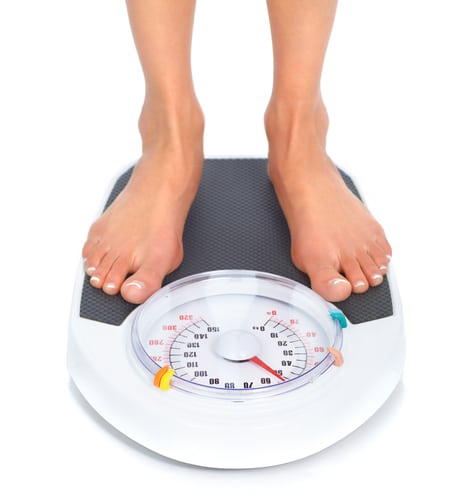
Even though this is a simple formula that’s handy for calculating ideal body weight, it says little about a person’s overall health or their risk factors for heart disease, type 2 diabetes, and other health problems. It doesn’t even give an indication of what type of shape you’re in. The weight a traditional scale spits back to you measures the weight of your organs, bones, fat tissue and muscle tissue. It reveals nothing about body composition – how much of your body weight is muscle tissue and how much is fat. For that, you would need a scale that measures body fat percentage.
Limitations of the Scale and Ideal Body Weight
If you’re 5’4″ and weigh 120 pounds, you may get a false sense of security when you step on the scale. After all, you’re at your ideal body weight – but what if your weight is 120 pounds and your body fat percentage is 35%? That certainly wouldn’t be a reason to celebrate. There are a significant number of people, particularly inactive people over the age of 40, who are skinny-fat. In medical lingo, this is called sarcopenia. It essentially means your weight is normal, but you’re carrying around too much body fat. As a result, you’re at greater risk for health problems.
How healthy you are has more to do with the amount of body fat you’re carrying than how much you weigh when you step on the scale. That’s why some athletes weigh more than their ideal body weight, but much of that weight is lean body mass or muscle. The number the scale spits back at you has to be taken in context.
Other Ways to Assess Body Composition and Health
So how do you know if you’re a “healthy” body weight or an unhealthy one? You can invest in a scale that measures body fat percentage, although not all of them are accurate, and your measured body fat percentage can vary depending on factors like how hydrated you are. You can also use calipers to measure body fat with some degree of accuracy. The other way to find out more about your body composition and health risk factors is to get out the tape measure.
The circumference of your waistline reveals more about general body composition and risk for health problems than the scale does. When you have a large waistline, you have too much visceral fat, the kind of abdominal fat that lies deep within the pelvic cavity. This is the type of fat that increases the risk of health problems like heart disease and type 2-diabetes. The “danger zone” is when a woman’s waistline grows to 35 inches or larger or a man’s is over 40 inches. That’s when the risk for health problems starts to climb, and the tape measure is a quick and easy way to see if your body composition puts you at greater risk.
The Bottom Line?
Don’t use the scale as an indicator of how healthy you are from a body composition standpoint. It gives you limited information. Use calipers or a body fat scale to measure your body fat percentage and a tape measure to measure the circumference of your waistline. It’ll give you a better idea of where you stand in terms of body composition and health.
Related Articles By Cathe:
How Much Weight Do You Have to Lose to Get Health Benefits?
What’s a Healthy Body Fat Percentage for Women?
A Better Way to Measure Body Fat?
What’s the Best Way to Track Your Body Fat Percentage?
6 Reasons Why BMI is Not the Best Indicator of Whether You’re a Healthy Body Weight
Why BMI is Not a Good Measure of Obesity in Women After Menopause
How Body Weight Impacts the Risk of Developing Type 2 Diabetes
Fitness vs. Body Weight: Which is Most Important for Health?
Why You Shouldn’t Depend on Exercise, Alone, to Lose or Maintain Your Body Weight

